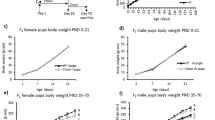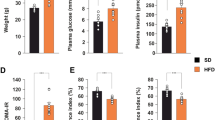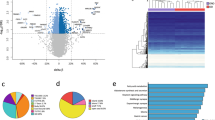Abstract
Opioid system dysregulation has been observed in both genetic and high-fat diet (HFD)-induced models of obesity. An understanding of the molecular mechanisms of MOR transcriptional regulation, particularly within an in vivo context, is lacking. Using a diet-induced model of obesity (DIO), mice were fed a high-fat diet (60% calories from fat) from weaning to >18 weeks of age. Compared with mice fed the control diet, DIO mice had a decreased preference for sucrose. MOR mRNA expression was decreased in reward-related circuitry (ventral tegmental area (VTA), nucleus accumbens (NAc), and prefrontal cortex (PFC)) but not the hypothalamus, important in the homeostatic regulation of feeding. DNA methylation is an epigenetic modification that links environmental exposures to altered gene expression. We found a significant increase in DNA methylation in the MOR promoter region within the reward-related brain regions. Methyl CpG-binding protein 2 (MeCP2) can bind methylated DNA and repress transcription, and DIO mice showed increased binding of MeCP2 to the MOR promoter in reward-related regions of the brain. Finally, using ChIP assays we examined H3K9 methylation (inactive chromatin) and H3 acetylation (active chromatin) within the MOR promoter region and found increased H3K9 methylation and decreased H3 acetylation. These data are the first to identify DNA methylation, MeCP2 recruitment, and chromatin remodeling as mechanisms leading to transcriptional repression of MOR in the brains of mice fed a high-fat diet.
Similar content being viewed by others
Log in or create a free account to read this content
Gain free access to this article, as well as selected content from this journal and more on nature.com
or
References
Alsiö J, Olszewski PK, Norbäck AH, Gunnarsson ZE, Levine AS, Pickering C et al (2010). Dopamine d1 receptor gene expression decreases in the nucleus accumbens upon long-term exposure to palatable food and differs depending on diet-induced obesity phenotype in rats. Neuroscience 171: 779–787.
Ammon-Treiber S, Höllt V (2005). Morphine-induced changes of gene expression in the brain. Addict Biol 10: 81–89.
Barnes MJ, Primeaux SD, Bray GA (2008). Food deprivation increases the mrna expression of micro-opioid receptors in the ventral medial hypothalamus and arcuate nucleus. Am J Physiol Regul Integr Comp Physiol 295: R1385–R1390.
Berrendero F, Robledo P, Trigo JM, Martín-García E, Maldonado R (2010). Neurobiological mechanisms involved in nicotine dependence and reward: Participation of the endogenous opioid system. Neurosci Biobehav Rev 35: 220–231.
Blendy JA, Strasser A, Walters CL, Perkins KA, Patterson F, Berkowitz R et al (2005). Reduced nicotine reward in obesity: cross-comparison in human and mouse. Psychopharmacology (Berl) 180: 306–315.
Chahrour M, Jung SY, Shaw C, Zhou X, Wong ST, Qin J et al (2008). Mecp2, a key contributor to neurological disease, activates and represses transcription. Science 320: 1224–1229.
Cleck JN, Ecke LE, Blendy JA (2008). Endocrine and gene expression changes following forced swim stress exposure during cocaine abstinence in mice. Psychopharmacology (Berl) 201: 15–28.
Cottone P, Sabino V, Roberto M, Bajo M, Pockros L, Frihauf JB et al (2009). Crf system recruitment mediates dark side of compulsive eating. Proc Natl Acad Sci USA 106: 20016–20020.
Coupé B, Amarger V, Grit I, Benani A, Parnet P (2010). Nutritional programming affects hypothalamic organization and early response to leptin. Endocrinology 151: 702–713.
Davis JF, Tracy AL, Schurdak JD, Tschöp MH, Lipton JW, Clegg DJ et al (2008). Exposure to elevated levels of dietary fat attenuates psychostimulant reward and mesolimbic dopamine turnover in the rat. Behav Neurosci 122: 1257–1263.
de Leeuw van Weenen JE, Hu L, Zelm KJ-V, Vries MGd, Tamsma JT, Romijn JA et al (2009). Four weeks high fat feeding induces insulin resistance without affecting dopamine release or gene expression patterns in the hypothalamus of c57bl6 mice. Brain Res 1250: 141–148.
Ellgren M, Spano SM, Hurd YL (2007). Adolescent cannabis exposure alters opiate intake and opioid limbic neuronal populations in adult rats. Neuropsychopharmacology 32: 607–615.
Ernst M, Romeo RD, Andersen SL (2009). Neurobiology of the development of motivated behaviors in adolescence: a window into a neural systems model. Pharmacol Biochem Behav 93: 199–211.
Field AE, Wing RR, Manson JE, Spiegelman DL, Willett WC (2001). Relationship of a large weight loss to long-term weight change among young and middle-aged us women. Int J obes Relat Metab Disord 25: 1113–1121.
Formisano L, Noh KM, Miyawaki T, Mashiko T, Bennett MV, Zukin RS (2007). Ischemic insults promote epigenetic reprogramming of mu opioid receptor expression in hippocampal neurons. Proc Natl Acad Sci USA 104: 4170–4175.
Gach K, Piestrzeniewicz M, Fichna J, Stefanska B, Szemraj J, Janecka A (2008). Opioid-induced regulation of mu-opioid receptor gene expression in the mcf-7 breast cancer cell line. Biochem Cell Biol 86: 217–226.
Geiger BM, Haburcak M, Avena NM, Moyer MC, Hoebel BG, Pothos EN (2009). Deficits of mesolimbic dopamine neurotransmission in rat dietary obesity. Neuroscience 159: 1193–1199.
Hwang CK, Song KY, Kim CS, Choi HS, Guo XH, Law PY et al (2007). Evidence of endogenous mu opioid receptor regulation by epigenetic control of the promoters. Mol Cell Biol 27: 4720–4736.
Hwang CK, Song KY, Kim CS, Choi HS, Guo XH, Law PY et al (2009). Epigenetic programming of mu-opioid receptor gene in mouse brain is regulated by mecp2 and brg1 chromatin remodelling factor. J Cell Mol Med 13: 3591–3615.
Johnson PM, Kenny PJ (2010). Dopamine D2 receptors in addiction-like reward dysfunction and compulsive eating in obese rats. Nat Neurosci 13: 635–641.
Khawaja XZ, Bailey CJ, Green IC (1989). Central mu, delta, and kappa opioid binding sites, and brain and pituitary beta-endorphin and met-enkephalin in genetically obese (ob/ob) and lean mice. Life Sci 44: 1097–1105.
Klein G, Rossi GC, Waxman AR, Arout C, Juni A, Inturrisi CE et al (2009). The contribution of mor-1 exons 1–4 to morphine and heroin analgesia and dependence. Neurosci Lett 457: 115–119.
Koob GF, le Moal M (2008). Addiction and the brain antireward system. Ann Rev Psychol 59: 29–53.
Kraus J, Lehmann L, Börner C, Höllt V (2010). Epigenetic mechanisms involved in the induction of the mu opioid receptor gene in jurkat t cells in response to interleukin-4. Mol Immunol 48: 257–263.
LaPlant Q, Vialou V, Covington HE, Dumitriu D, Feng J, Warren BL et al (2010). Dnmt3a regulates emotional behavior and spine plasticity in the nucleus accumbens. Nat Neurosci 13: 1137–1143.
Lee AK, Mojtahed-Jaberi M, Kyriakou T, Astarloa EA, Arno M, Marshall NJ et al (2010a). Effect of high-fat feeding on expression of genes controlling availability of dopamine in mouse hypothalamus. Nutrition 26: 411–422.
Lee DY, Hayes JJ, Pruss D, Wolff AP (1993). A positive role for histone acetylation in transcription factor access to nucleosomal DNA. Cell 72: 73–84.
Lee RS, Tamashiro KL, Yang X, Purcell RH, Harvey A, Willour VL et al (2010b). Chronic corticosterone exposure increases expression and decreases deoxyribonucleic acid methylation of fkbp5 in mice. Endocrinology 151: 4332–4343.
Leibowitz SF (2007). Overconsumption of dietary fat and alcohol: mechanisms involving lipids and hypothalamic peptides. Physiol Behav 91: 513–521.
Leri F, Zhou Y, Goddard B, Cummins E, Kreek MJ (2006). Effects of high-dose methadone maintenance on cocaine place conditioning, cocaine self-administration, and mu-opioid receptor mrna expression in the rat brain. Neuropsychopharmacology 31: 1462–1474.
Lubin FD, Roth TL, Sweatt JD (2008). Epigenetic regulation of bdnf gene transcription in the consolidation of fear memory. J Neurosci 28: 10576–10586.
Ma DK, Jang MH, Guo JU, Kitabatake Y, Chang ML, Pow-Anpongkul N et al (2009). Neuronal activity-induced gadd45b promotes epigenetic DNA demethylation and adult neurogenesis. Science 323: 1074–1077.
Matysková R, Maletínská L, Maixnerová J, Pirník Z, Kiss A, Zelezná B (2008). Comparison of the obesity phenotypes related to monosodium glutamate effect on arcuate nucleus and/or the high fat diet feeding in c57bl/6 and nmri mice. Physiol Res 57: 727–734.
Merrer JL, Becker JA, Befort K, Kieffer BL (2009). Reward processing by the opioid system in the brain. Physiol Rev 89: 1379–1412.
Miller CA, Gavin CF, White JA, Parrish RR, Honasoge A, Yancey CR et al (2010). Cortical DNA methylation maintains remote memory. Nat Neurosci 13: 664–666.
Murgatroyd C, Patchev AV, Wu Y, Micale V, Bockmühl Y, Fischer D et al (2009). Dynamic DNA methylation programs persistent adverse effects of early-life stress. Nat Neurosci 12: 1559–1566.
Niculescu MD, Craciunescu CN, Zeisel SH (2006). Dietary choline deficiency alters global and gene-specific DNA methylation in the developing hippocampus of mouse fetal brains. FASEB J 20: 43–49.
Niculescu MD, Lupu DS (2009). High fat diet-induced maternal obesity alters fetal hippocampal development. Int J Dev Neurosci 27: 627–633.
Nikoshkov A, Drakenberg K, Wang X, Horvath MC, Keller E, Hurd YL (2008). Opioid neuropeptide genotypes in relation to heroin abuse: Dopamine tone contributes to reversed mesolimbic proenkephalin expression. Proc Natl Acad Sci USA 105: 786–791.
Pankevich DE, Teegarden SL, Hedin AD, Jensen CL, Bale TL (2010). Caloric restriction experience reprograms stress and orexigenic pathways and promotes binge eating. J Neurosci 30: 16399–16407.
Pfaffl MW (2001). A new mathematical model for relative quantification in real-time rt-pcr. Nucleic Acids Res 20: e45.
Phelan S, Wing RR, Loria CM, Kim Y, Lewis CE (2010). Prevalence and predictors of weight-loss maintenance in a biracial cohort results from the coronary artery risk development in young adults study. Am J Prev Med 39: 546–554.
Plagemann A, Harder T, Brunn M, Harder A, Roepke K, Wittrock-Staar M et al (2009). Hypothalamic proopiomelanocortin promoter methylation becomes altered by early overfeeding: An epigenetic model of obesity and the metabolic syndrome. J Physiol 587: 4963–4976.
Renthal W, Maze I, Krishnan V, Covington III HE, Xiao G, Kumar A et al (2007). Histone deacetylase 5 epigenetically controls behavioral adaptations to chronic emotional stimuli. Neuron 56: 517–529.
Reyes T, Walker JR, DeCino C, Hogenesch JB, Sawchenko PE (2003). Categorically distinct acute stressors elicit dissimilar transcriptional profiles in the paraventricular nucleus of the hypothalamus. J Neurosci 23: 5607–5616.
Schroeder FA, Penta KL, Matevossian A, Jones SR, Konradi C, Tapper AR et al (2008). Drug-induced activation of dopamine d(1) receptor signaling and inhibition of class i/ii histone deacetylase induce chromatin remodeling in reward circuitry and modulate cocaine-related behaviors. Neuropsychopharmacology 33: 2981–2992.
Sherry B, Blanck HM, Galuska DA, Pan L, Dietz WH, Balluz L (2010). Vital signs: state-specific obesity prevalence among adults—united states, 2009. MMWR 59: 1–5.
Smith SL, Harrold JA, Williams G (2002). Diet-induced obesity increases mu opioid receptor binding in specific regions of the rat brain. Brain Res 953: 215–222.
Snowden AW, Gregory PD, Case CC, Pabo CO (2002). Gene-specific targeting of h3k9 methylation is sufficient for initiating repression in vivo. Curr Biol 12: 2159–2166.
Stice E, Spoor S, Bohon C, Small DM (2008). Relation between obesity and blunted striatal response to food is moderated by taqia a1 allele. Science 322: 449–452.
Vucetic Z, Kimmel J, Totoki K, Hollenbeck E, Reyes TM (2010a). Maternal high-fat diet alters methylation and gene expression of dopamine and opioid-related genes. Endocrinology 151: 4756–4764.
Vucetic Z, Totoki K, Schoch H, Whitaker KW, Hill-Smith T, Lucki I et al (2010b). Early life protein restriction alters dopamine circuitry. Neuroscience 168: 359–370.
Wang GJ, Volkow ND, Logan J, Pappas NR, Wong CT, Zhu W et al (2001). Brain dopamine and obesity. Lancet 357: 1883.
Ward SJ, Roberts DC (2007). Microinjection of the delta-opioid receptor selective antagonist naltrindole 5′-isothiocyanate site specifically affects cocaine self-administration in rats responding under a progressive ratio schedule of reinforcement. Behav Brain Res 182: 140–144.
Weaver I, Cervoni N, Champagne FA, D’Alessio AC, Sharma S, Seckl JR et al (2004). Epigenetic programming by maternal behavior. Nat Neurosci 7: 847–854.
Weber M, Davies JD, Wittig D, Oakeley EJ, Haase M, Wan L et al (2005). Chromosome-wide and promoter-specific analyses identify sites of differential DNA methylation in normal and transformed human cells. Nat Genet 37: 853–862.
Wei LN, Loh HH (2011). Transcriptional and epigenetic regulation of opioid receptor genes;present and future. Annu Rev Pharmacol Toxicol 51: 75–97.
Widiker S, Karst S, Wagener A, Brockmann GA (2010). High-fat diet leads to a decreased methylation of the mc4r gene in the obese bfmi and the lean b6 mouse lines. J Appl Genet 51: 193–197.
Zhou Z, Hong EJ, Cohen S, Zhao WN, Ho HY, Schmidt L et al (2006). Brain-specific phosphorylation of mecp2 regulates activity-dependent bdnf transcription, dendritic growth, and spine maturation. Neuron 52: 255–269.
Acknowledgements
We thank Kathy Totoki for technical assistance. The current work was supported by NIH DK064086 (Reyes) and MH091372 (Reyes).
Author information
Authors and Affiliations
Corresponding author
Ethics declarations
Competing interests
The authors declare no conflict of interest.
Additional information
Supplementary Information accompanies the paper on the Neuropsychopharmacology website
Supplementary information
Rights and permissions
About this article
Cite this article
Vucetic, Z., Kimmel, J. & Reyes, T. Chronic High-Fat Diet Drives Postnatal Epigenetic Regulation of μ-Opioid Receptor in the Brain. Neuropsychopharmacol 36, 1199–1206 (2011). https://doi.org/10.1038/npp.2011.4
Received:
Revised:
Accepted:
Published:
Issue date:
DOI: https://doi.org/10.1038/npp.2011.4
Keywords
This article is cited by
-
Integrated analysis of behavioral, epigenetic, and gut microbiome analyses in AppNL-G-F, AppNL-F, and wild type mice
Scientific Reports (2021)
-
A limited and intermittent access to a high-fat diet modulates the effects of cocaine-induced reinstatement in the conditioned place preference in male and female mice
Psychopharmacology (2021)
-
Chronic stress, epigenetics, and adipose tissue metabolism in the obese state
Nutrition & Metabolism (2020)
-
FABP7 Regulates Acetyl-CoA Metabolism Through the Interaction with ACLY in the Nucleus of Astrocytes
Molecular Neurobiology (2020)
-
Sucrose intake lowers μ-opioid and dopamine D2/3 receptor availability in porcine brain
Scientific Reports (2019)



